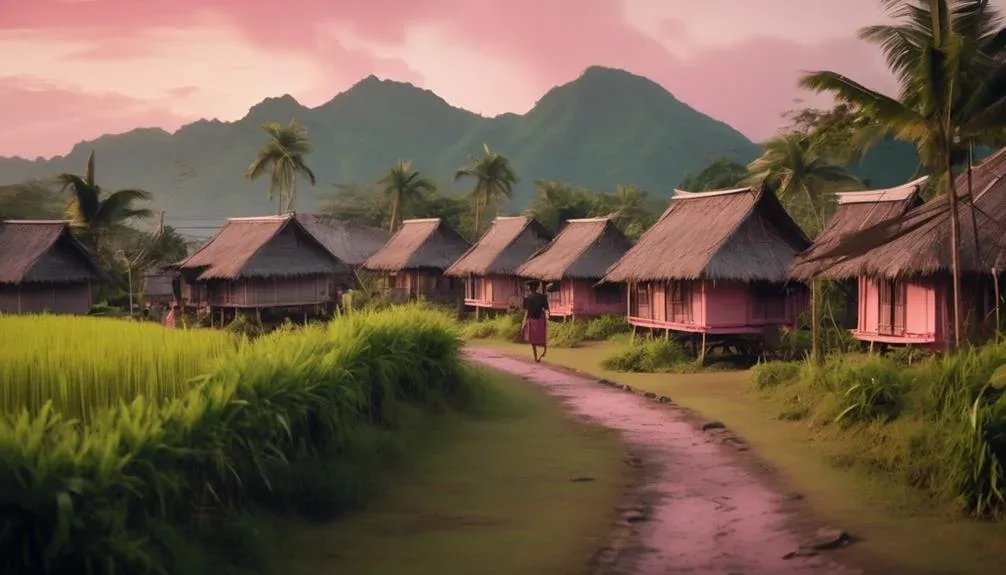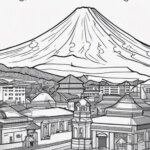You might think that exploring old villages in the Philippines is purely a journey back in time, but it's much more than that. As you embark on this expedition, you'll uncover not just the pre-colonial history, but also a rich cultural tapestry that's alive and evolving. From indigenous heritage to archaeological wonders, each village tells a unique story of resilience, heritage conservation, and cultural evolution. As we guide you through these historical landscapes, you'll find that the past and present coexist in a fascinating dance of traditions and modernity. What awaits is not only an enlightenment of the Philippines' ancestral past but a newfound appreciation for how these communities thrive while preserving their legacy. So, why should you take this journey? The answer lies in the untold stories and the undying spirit of these age-old villages, waiting to be discovered by those who seek to understand the depth of Filipino heritage.
Key Takeaways
- Indigenous heritage and pre-colonial history play a significant role in the cultural landscape of the Philippines.
- The cultural tapestry of the Philippines reflects a blend of indigenous traditions and pre-colonial influences.
- Archaeological sites in the Philippines offer a glimpse into ancient civilizations and their daily lives.
- Community involvement and sustainable tourism practices are crucial for the preservation of heritage sites in the Philippines.
Indigenous Heritage Overview
Delving into the indigenous heritage of the Philippines reveals a tapestry of ancient cultures and traditions, each village telling its own unique story of survival and adaptation. You'll find that the heart of these stories often beats through their tribal languages and traditional attire, elements that are not just remnants of the past but living embodiments of a vibrant cultural identity.
Tribal languages, intricately woven into the daily lives of indigenous communities, serve as a testament to their resilience. These languages are not mere means of communication; they're vessels of wisdom, carrying centuries of knowledge, folklore, and traditions. They provide insight into the indigenous people's profound connection with nature, their ancestors, and their cosmologies, making them indispensable to understanding the Philippines' cultural landscape.
Similarly, traditional attire stands as a symbol of pride and heritage. Each piece, from the patterns woven into the fabrics to the accessories that adorn them, tells a story of the people's journeys, battles, and celebrations. These garments are more than just clothing; they're a declaration of identity, crafted with techniques passed down through generations.
Exploring indigenous heritage in the Philippines, you're not just uncovering history; you're witnessing the enduring strength and beauty of cultures that have thrived amidst challenges, preserving their unique identity through tribal languages and traditional attire.
Pre-Colonial History Unveiled
Exploring beyond the rich tapestry of indigenous heritage, you'll uncover the Philippines' pre-colonial history, a period that shaped the very foundation of its vibrant cultures and traditions. This era, largely undocumented in written form, is vividly alive through oral histories, ancient artifacts, and enduring practices that have woven their way into the fabric of modern Filipino society.
Delving deeper, you'll find that trade routes played a pivotal role in the pre-colonial Philippines, not just in commerce but in the exchange of ideas, technologies, and spiritual beliefs. These ancient pathways connected the archipelago to the broader Southeast Asian region and beyond, fostering a dynamic interplay of cultures.
Ancestral beliefs, deeply rooted in the natural world, guided daily life and societal norms. These beliefs, encompassing animism and a profound respect for nature, shaped community rituals, practices, and governance, embedding a sense of interconnectedness with the environment that is palpable even today.
| Aspect | Description | Influence |
|---|---|---|
| Trade Routes | Vital for commerce and cultural exchange | Fostered dynamic interplay of ideas |
| Ancestral Beliefs | Rooted in nature and animism | Shaped rituals, practices, governance |
| Community Life | Governed by consensus and respect for nature | Influenced modern Filipino values |
This tableau offers a glimpse into a complex, interconnected society that thrived before colonial influences, highlighting the resilience and ingenuity of the Filipino people.
Cultural Tapestry Explored
The cultural tapestry of the Philippines is a vibrant mosaic, reflecting a rich blend of indigenous traditions, pre-colonial influences, and the enduring spirit of its people. As you delve deeper, you'll uncover the profound connection between the land's history and its contemporary expressions of culture. Among these, folk festivals and local crafts stand out, weaving a colorful narrative of the Filipino identity.
- Folk Festivals: These events are more than just celebrations; they are a pulsating heartbeat of the Filipino community. Each dance step and musical note played tells a story of triumph, of seasons, of life and death. They're a testament to the resilience and joy that permeate the Philippine archipelago.
- Local Crafts: Hand-woven textiles, intricately carved woodwork, and pottery showcase not just the artistic skills but also the environmental consciousness of the Filipino people. These crafts are a dialogue with nature, shaped by the very hands that till the land and sail the seas.
- Community Spirit: Perhaps the most touching aspect is the communal spirit that binds these festivals and crafts. It's a reflection of bayanihan, the Filipino value of communal unity and cooperation, which has stood the test of time.
Exploring the cultural tapestry of the Philippines, you're not just observing; you're immersing yourself in a living, breathing narrative of resilience, creativity, and communal harmony.
Archaeological Wonders Highlighted
Beneath your feet lies a treasure trove of history, where archaeological sites across the Philippines offer a silent narrative of ancient civilizations, their innovations, and the mysteries of their daily lives. Delving into these sites, you're not just unearthing artifacts; you're piecing together stories untold for centuries. The meticulous excavation techniques employed reveal the dedication to preserving every shard of pottery, every bone, and every remnant of structures that once stood proudly. These techniques are not just about digging; they're an intricate dance of science and respect for the past, ensuring that nothing is lost to the whims of time.
As you explore further, the aspect of artifact preservation comes to the forefront, showcasing a commitment to safeguarding these treasures for future generations. It's a meticulous process, involving both the physical stabilization of artifacts and the digital documentation of their stories. This dual approach ensures that while the artifacts themselves are preserved, their tales, too, are kept alive, accessible for researchers and enthusiasts alike. Through these efforts, the archaeological wonders of the Philippines stand as a testament to the rich tapestry of human history nestled within its islands, inviting you to look closer and understand the profound legacy they hold.
Heritage Conservation Strategies
As we uncover the physical remnants of ancient civilizations, it's crucial to examine the strategies employed to conserve these heritage sites for posterity. Facing modern challenges head-on, the Philippines has crafted innovative approaches to safeguard its historical villages, blending traditional wisdom with contemporary techniques. Here's how:
- Community Involvement: You'll find that local communities are not just bystanders but active participants in preservation efforts. Their intimate knowledge and cultural connections breathe life into conservation, making it a shared journey rather than a distant mandate.
- Legislation and Policies: The government has stepped up, enacting laws and policies that prioritize heritage conservation. This legal framework ensures that development and progress don't overshadow the need to protect our historical legacy.
- Sustainable Tourism Practices: Embracing sustainable tourism ensures that while these sites attract visitors, they don't succumb to the wear and tear of modern foot traffic. It's a delicate balance between showcasing the beauty of these ancient villages and ensuring they withstand the test of time.
Through these strategies, the Philippines is setting a precedent in heritage conservation, addressing the dual challenges of preserving history and embracing sustainable growth.
Frequently Asked Questions
What Are the Transportation Options and Estimated Costs to Reach These Old Villages in the Philippines From Major Cities?
You've got buses, ferries, and local flights as options. Costs vary widely, but travel apps can help you budget. Keeping luggage light is wise; it's easier for hopping between locations and saves costs.
Can Visitors Participate in Local Traditions or Ceremonies, and Are There Specific Protocols or Permissions Required?
You can join in local traditions or ceremonies, but cultural respect is paramount. Always seek permission first. Wearing traditional attire might be required, showing your understanding and appreciation of their customs and way of life.
Are There Any Health or Safety Concerns Specific to These Areas That Travelers Should Be Aware of Before Visiting?
Before visiting, you should be aware of health or safety concerns. Vaccine recommendations are crucial to prevent local diseases. Also, understanding climate considerations helps you prepare for weather-related challenges, ensuring a safer, more enjoyable trip.
What Accommodations Are Available for Tourists in or Near These Ancient Villages, and Do They Cater to Various Budget Ranges?
You'll find accommodations ranging from budget-friendly guesthouses to upscale lodges near the ancient villages, all embracing village cuisine and cultural preservation, ensuring an immersive experience that respects the local heritage and community.
How Do Local Communities in These Old Villages Benefit From Tourism, and Are There Ways for Tourists to Contribute Positively to Their Economy or Well-Being?
Local communities benefit through cultural preservation and reduced environmental impact. You can contribute by supporting local businesses and respecting traditions. This boosts the economy and well-being, ensuring a positive interaction between tourists and the local community.
Conclusion
In exploring the ancient villages of the Philippines, you've ventured through a rich tapestry of indigenous heritage and pre-colonial history, unveiling a cultural mosaic that is as diverse as it is profound. The archaeological wonders you've encountered not only highlight the ingenuity of ancient Filipinos but also underscore the urgent need for heritage conservation. As you reflect on these insights, it's clear that preserving these sites is crucial for understanding not just the past, but also shaping a more informed future.



